Professional Communication in Nursing: Annotated Bibliography Analysis
VerifiedAdded on 2021/04/24
|8
|1711
|131
Homework Assignment
AI Summary
This assignment provides an annotated bibliography focusing on professional communication in nursing. It explores the significance of effective communication skills, including emotional intelligence, therapeutic communication techniques, and strategies for overcoming intercultural communication challenges. The assignment analyzes several research papers, highlighting their strengths, limitations, and implications for nursing practice. Key topics covered include the importance of emotional intelligence in improving patient safety, the use of therapeutic communication to build rapport and reduce patient stress, and strategies for addressing intercultural communication barriers. Based on the research, the assignment recommends integrating these skills into nursing education and personal practice to enhance patient outcomes and promote a more compassionate and effective healthcare environment. The bibliography includes a detailed analysis of each source, offering insights into the practical application of these communication strategies.
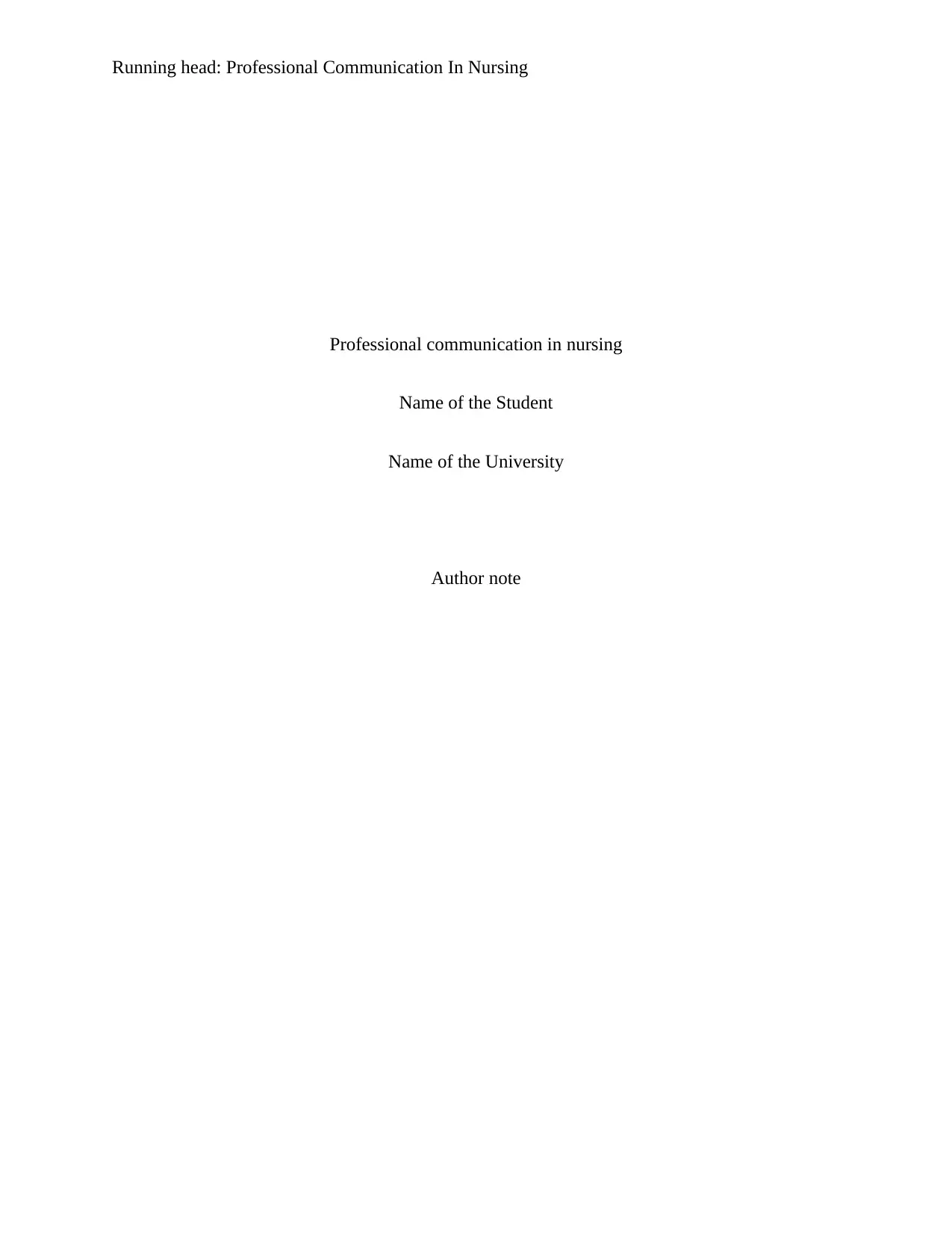
Running head: Professional Communication In Nursing
Professional communication in nursing
Name of the Student
Name of the University
Author note
Professional communication in nursing
Name of the Student
Name of the University
Author note
Paraphrase This Document
Need a fresh take? Get an instant paraphrase of this document with our AI Paraphraser
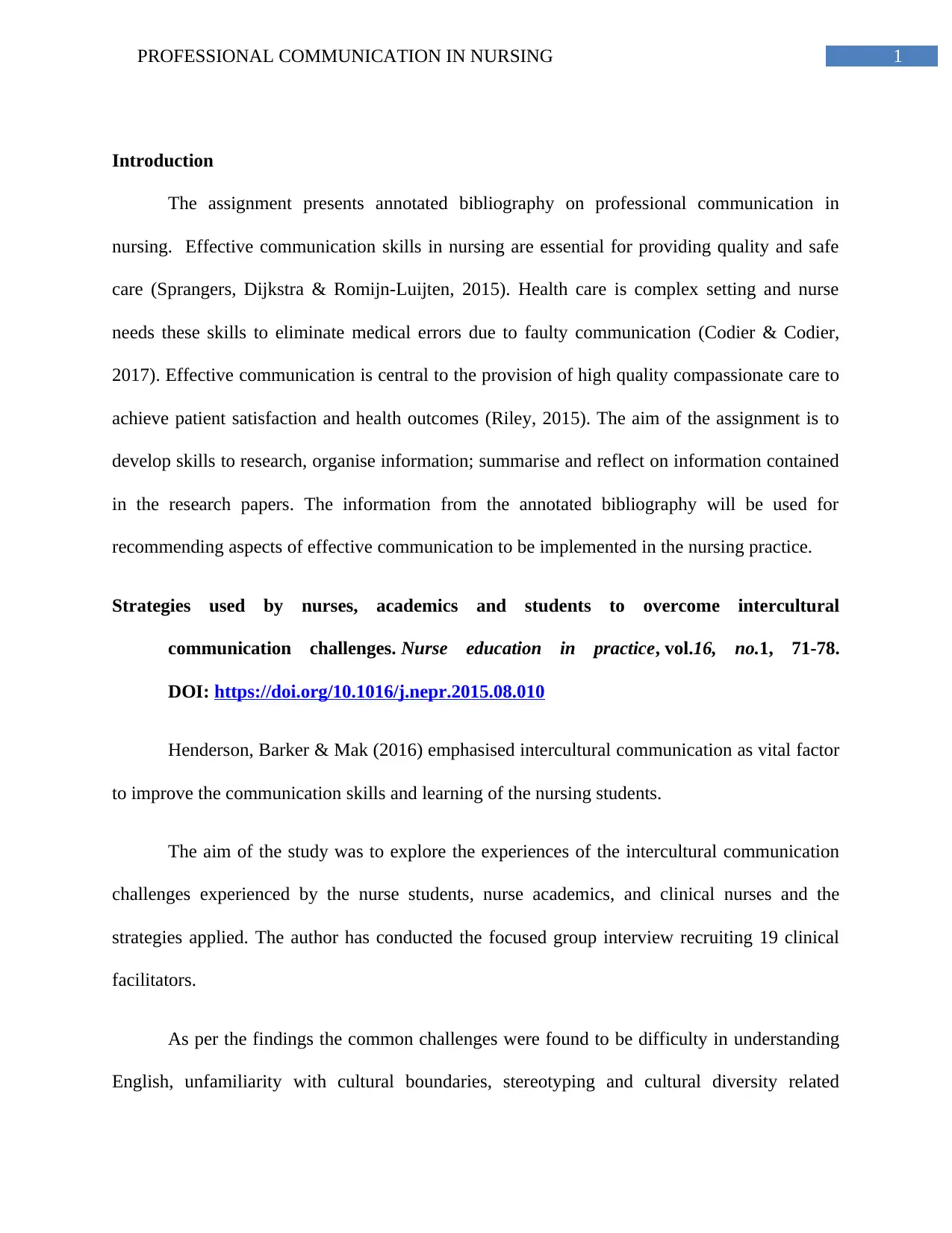
1PROFESSIONAL COMMUNICATION IN NURSING
Introduction
The assignment presents annotated bibliography on professional communication in
nursing. Effective communication skills in nursing are essential for providing quality and safe
care (Sprangers, Dijkstra & Romijn-Luijten, 2015). Health care is complex setting and nurse
needs these skills to eliminate medical errors due to faulty communication (Codier & Codier,
2017). Effective communication is central to the provision of high quality compassionate care to
achieve patient satisfaction and health outcomes (Riley, 2015). The aim of the assignment is to
develop skills to research, organise information; summarise and reflect on information contained
in the research papers. The information from the annotated bibliography will be used for
recommending aspects of effective communication to be implemented in the nursing practice.
Strategies used by nurses, academics and students to overcome intercultural
communication challenges. Nurse education in practice, vol.16, no.1, 71-78.
DOI: https://doi.org/10.1016/j.nepr.2015.08.010
Henderson, Barker & Mak (2016) emphasised intercultural communication as vital factor
to improve the communication skills and learning of the nursing students.
The aim of the study was to explore the experiences of the intercultural communication
challenges experienced by the nurse students, nurse academics, and clinical nurses and the
strategies applied. The author has conducted the focused group interview recruiting 19 clinical
facilitators.
As per the findings the common challenges were found to be difficulty in understanding
English, unfamiliarity with cultural boundaries, stereotyping and cultural diversity related
Introduction
The assignment presents annotated bibliography on professional communication in
nursing. Effective communication skills in nursing are essential for providing quality and safe
care (Sprangers, Dijkstra & Romijn-Luijten, 2015). Health care is complex setting and nurse
needs these skills to eliminate medical errors due to faulty communication (Codier & Codier,
2017). Effective communication is central to the provision of high quality compassionate care to
achieve patient satisfaction and health outcomes (Riley, 2015). The aim of the assignment is to
develop skills to research, organise information; summarise and reflect on information contained
in the research papers. The information from the annotated bibliography will be used for
recommending aspects of effective communication to be implemented in the nursing practice.
Strategies used by nurses, academics and students to overcome intercultural
communication challenges. Nurse education in practice, vol.16, no.1, 71-78.
DOI: https://doi.org/10.1016/j.nepr.2015.08.010
Henderson, Barker & Mak (2016) emphasised intercultural communication as vital factor
to improve the communication skills and learning of the nursing students.
The aim of the study was to explore the experiences of the intercultural communication
challenges experienced by the nurse students, nurse academics, and clinical nurses and the
strategies applied. The author has conducted the focused group interview recruiting 19 clinical
facilitators.
As per the findings the common challenges were found to be difficulty in understanding
English, unfamiliarity with cultural boundaries, stereotyping and cultural diversity related
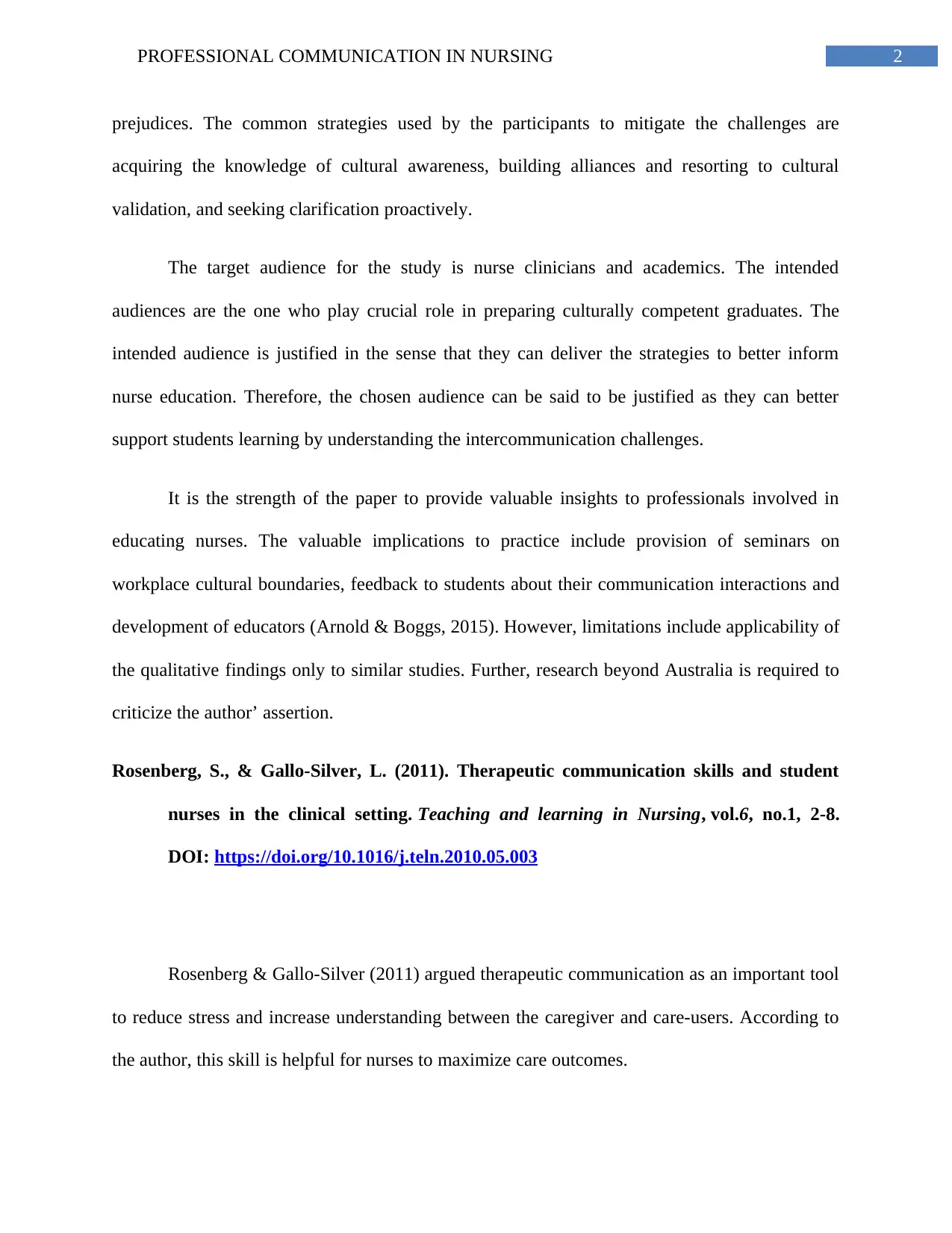
2PROFESSIONAL COMMUNICATION IN NURSING
prejudices. The common strategies used by the participants to mitigate the challenges are
acquiring the knowledge of cultural awareness, building alliances and resorting to cultural
validation, and seeking clarification proactively.
The target audience for the study is nurse clinicians and academics. The intended
audiences are the one who play crucial role in preparing culturally competent graduates. The
intended audience is justified in the sense that they can deliver the strategies to better inform
nurse education. Therefore, the chosen audience can be said to be justified as they can better
support students learning by understanding the intercommunication challenges.
It is the strength of the paper to provide valuable insights to professionals involved in
educating nurses. The valuable implications to practice include provision of seminars on
workplace cultural boundaries, feedback to students about their communication interactions and
development of educators (Arnold & Boggs, 2015). However, limitations include applicability of
the qualitative findings only to similar studies. Further, research beyond Australia is required to
criticize the author’ assertion.
Rosenberg, S., & Gallo-Silver, L. (2011). Therapeutic communication skills and student
nurses in the clinical setting. Teaching and learning in Nursing, vol.6, no.1, 2-8.
DOI: https://doi.org/10.1016/j.teln.2010.05.003
Rosenberg & Gallo-Silver (2011) argued therapeutic communication as an important tool
to reduce stress and increase understanding between the caregiver and care-users. According to
the author, this skill is helpful for nurses to maximize care outcomes.
prejudices. The common strategies used by the participants to mitigate the challenges are
acquiring the knowledge of cultural awareness, building alliances and resorting to cultural
validation, and seeking clarification proactively.
The target audience for the study is nurse clinicians and academics. The intended
audiences are the one who play crucial role in preparing culturally competent graduates. The
intended audience is justified in the sense that they can deliver the strategies to better inform
nurse education. Therefore, the chosen audience can be said to be justified as they can better
support students learning by understanding the intercommunication challenges.
It is the strength of the paper to provide valuable insights to professionals involved in
educating nurses. The valuable implications to practice include provision of seminars on
workplace cultural boundaries, feedback to students about their communication interactions and
development of educators (Arnold & Boggs, 2015). However, limitations include applicability of
the qualitative findings only to similar studies. Further, research beyond Australia is required to
criticize the author’ assertion.
Rosenberg, S., & Gallo-Silver, L. (2011). Therapeutic communication skills and student
nurses in the clinical setting. Teaching and learning in Nursing, vol.6, no.1, 2-8.
DOI: https://doi.org/10.1016/j.teln.2010.05.003
Rosenberg & Gallo-Silver (2011) argued therapeutic communication as an important tool
to reduce stress and increase understanding between the caregiver and care-users. According to
the author, this skill is helpful for nurses to maximize care outcomes.
⊘ This is a preview!⊘
Do you want full access?
Subscribe today to unlock all pages.

Trusted by 1+ million students worldwide
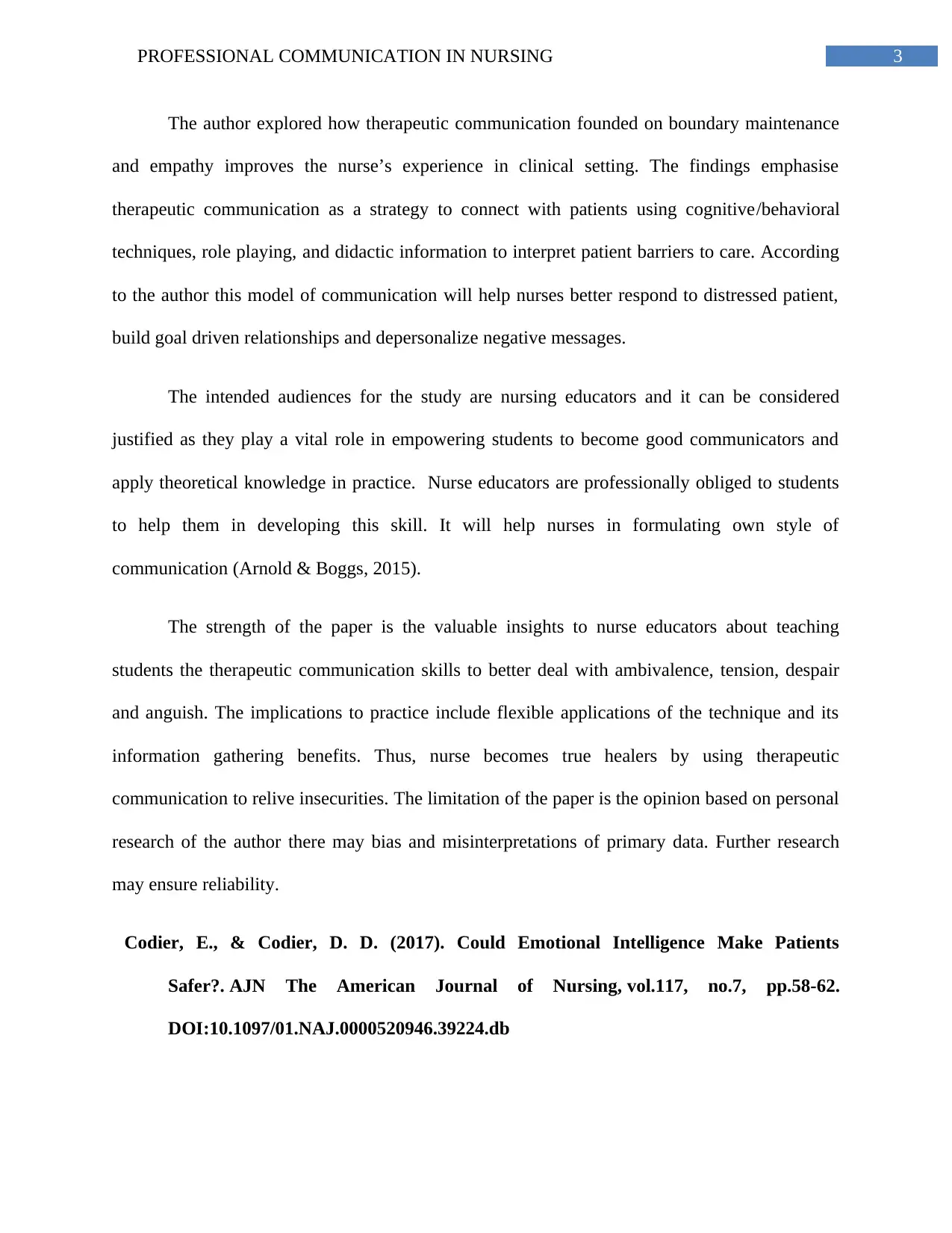
3PROFESSIONAL COMMUNICATION IN NURSING
The author explored how therapeutic communication founded on boundary maintenance
and empathy improves the nurse’s experience in clinical setting. The findings emphasise
therapeutic communication as a strategy to connect with patients using cognitive/behavioral
techniques, role playing, and didactic information to interpret patient barriers to care. According
to the author this model of communication will help nurses better respond to distressed patient,
build goal driven relationships and depersonalize negative messages.
The intended audiences for the study are nursing educators and it can be considered
justified as they play a vital role in empowering students to become good communicators and
apply theoretical knowledge in practice. Nurse educators are professionally obliged to students
to help them in developing this skill. It will help nurses in formulating own style of
communication (Arnold & Boggs, 2015).
The strength of the paper is the valuable insights to nurse educators about teaching
students the therapeutic communication skills to better deal with ambivalence, tension, despair
and anguish. The implications to practice include flexible applications of the technique and its
information gathering benefits. Thus, nurse becomes true healers by using therapeutic
communication to relive insecurities. The limitation of the paper is the opinion based on personal
research of the author there may bias and misinterpretations of primary data. Further research
may ensure reliability.
Codier, E., & Codier, D. D. (2017). Could Emotional Intelligence Make Patients
Safer?. AJN The American Journal of Nursing, vol.117, no.7, pp.58-62.
DOI:10.1097/01.NAJ.0000520946.39224.db
The author explored how therapeutic communication founded on boundary maintenance
and empathy improves the nurse’s experience in clinical setting. The findings emphasise
therapeutic communication as a strategy to connect with patients using cognitive/behavioral
techniques, role playing, and didactic information to interpret patient barriers to care. According
to the author this model of communication will help nurses better respond to distressed patient,
build goal driven relationships and depersonalize negative messages.
The intended audiences for the study are nursing educators and it can be considered
justified as they play a vital role in empowering students to become good communicators and
apply theoretical knowledge in practice. Nurse educators are professionally obliged to students
to help them in developing this skill. It will help nurses in formulating own style of
communication (Arnold & Boggs, 2015).
The strength of the paper is the valuable insights to nurse educators about teaching
students the therapeutic communication skills to better deal with ambivalence, tension, despair
and anguish. The implications to practice include flexible applications of the technique and its
information gathering benefits. Thus, nurse becomes true healers by using therapeutic
communication to relive insecurities. The limitation of the paper is the opinion based on personal
research of the author there may bias and misinterpretations of primary data. Further research
may ensure reliability.
Codier, E., & Codier, D. D. (2017). Could Emotional Intelligence Make Patients
Safer?. AJN The American Journal of Nursing, vol.117, no.7, pp.58-62.
DOI:10.1097/01.NAJ.0000520946.39224.db
Paraphrase This Document
Need a fresh take? Get an instant paraphrase of this document with our AI Paraphraser
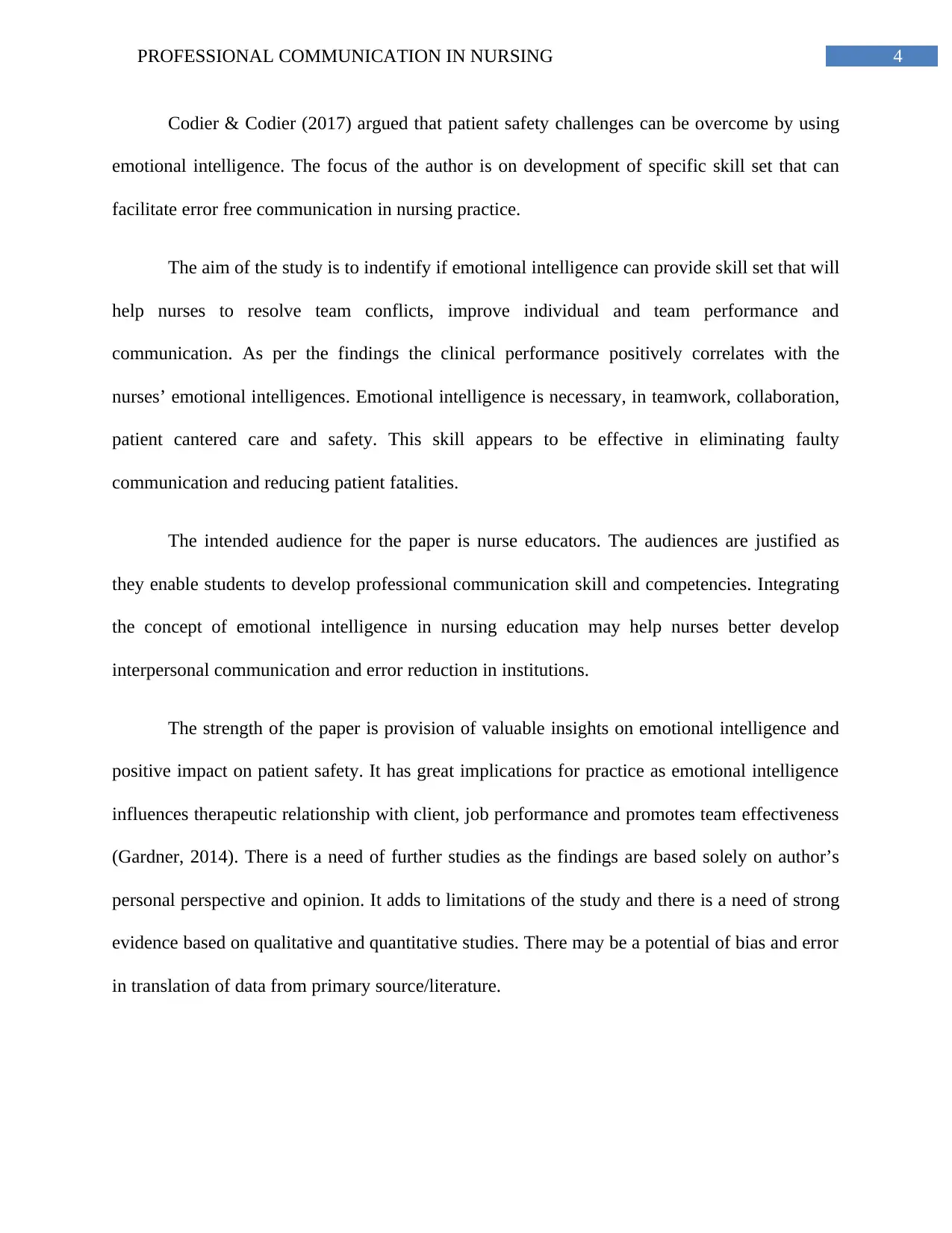
4PROFESSIONAL COMMUNICATION IN NURSING
Codier & Codier (2017) argued that patient safety challenges can be overcome by using
emotional intelligence. The focus of the author is on development of specific skill set that can
facilitate error free communication in nursing practice.
The aim of the study is to indentify if emotional intelligence can provide skill set that will
help nurses to resolve team conflicts, improve individual and team performance and
communication. As per the findings the clinical performance positively correlates with the
nurses’ emotional intelligences. Emotional intelligence is necessary, in teamwork, collaboration,
patient cantered care and safety. This skill appears to be effective in eliminating faulty
communication and reducing patient fatalities.
The intended audience for the paper is nurse educators. The audiences are justified as
they enable students to develop professional communication skill and competencies. Integrating
the concept of emotional intelligence in nursing education may help nurses better develop
interpersonal communication and error reduction in institutions.
The strength of the paper is provision of valuable insights on emotional intelligence and
positive impact on patient safety. It has great implications for practice as emotional intelligence
influences therapeutic relationship with client, job performance and promotes team effectiveness
(Gardner, 2014). There is a need of further studies as the findings are based solely on author’s
personal perspective and opinion. It adds to limitations of the study and there is a need of strong
evidence based on qualitative and quantitative studies. There may be a potential of bias and error
in translation of data from primary source/literature.
Codier & Codier (2017) argued that patient safety challenges can be overcome by using
emotional intelligence. The focus of the author is on development of specific skill set that can
facilitate error free communication in nursing practice.
The aim of the study is to indentify if emotional intelligence can provide skill set that will
help nurses to resolve team conflicts, improve individual and team performance and
communication. As per the findings the clinical performance positively correlates with the
nurses’ emotional intelligences. Emotional intelligence is necessary, in teamwork, collaboration,
patient cantered care and safety. This skill appears to be effective in eliminating faulty
communication and reducing patient fatalities.
The intended audience for the paper is nurse educators. The audiences are justified as
they enable students to develop professional communication skill and competencies. Integrating
the concept of emotional intelligence in nursing education may help nurses better develop
interpersonal communication and error reduction in institutions.
The strength of the paper is provision of valuable insights on emotional intelligence and
positive impact on patient safety. It has great implications for practice as emotional intelligence
influences therapeutic relationship with client, job performance and promotes team effectiveness
(Gardner, 2014). There is a need of further studies as the findings are based solely on author’s
personal perspective and opinion. It adds to limitations of the study and there is a need of strong
evidence based on qualitative and quantitative studies. There may be a potential of bias and error
in translation of data from primary source/literature.
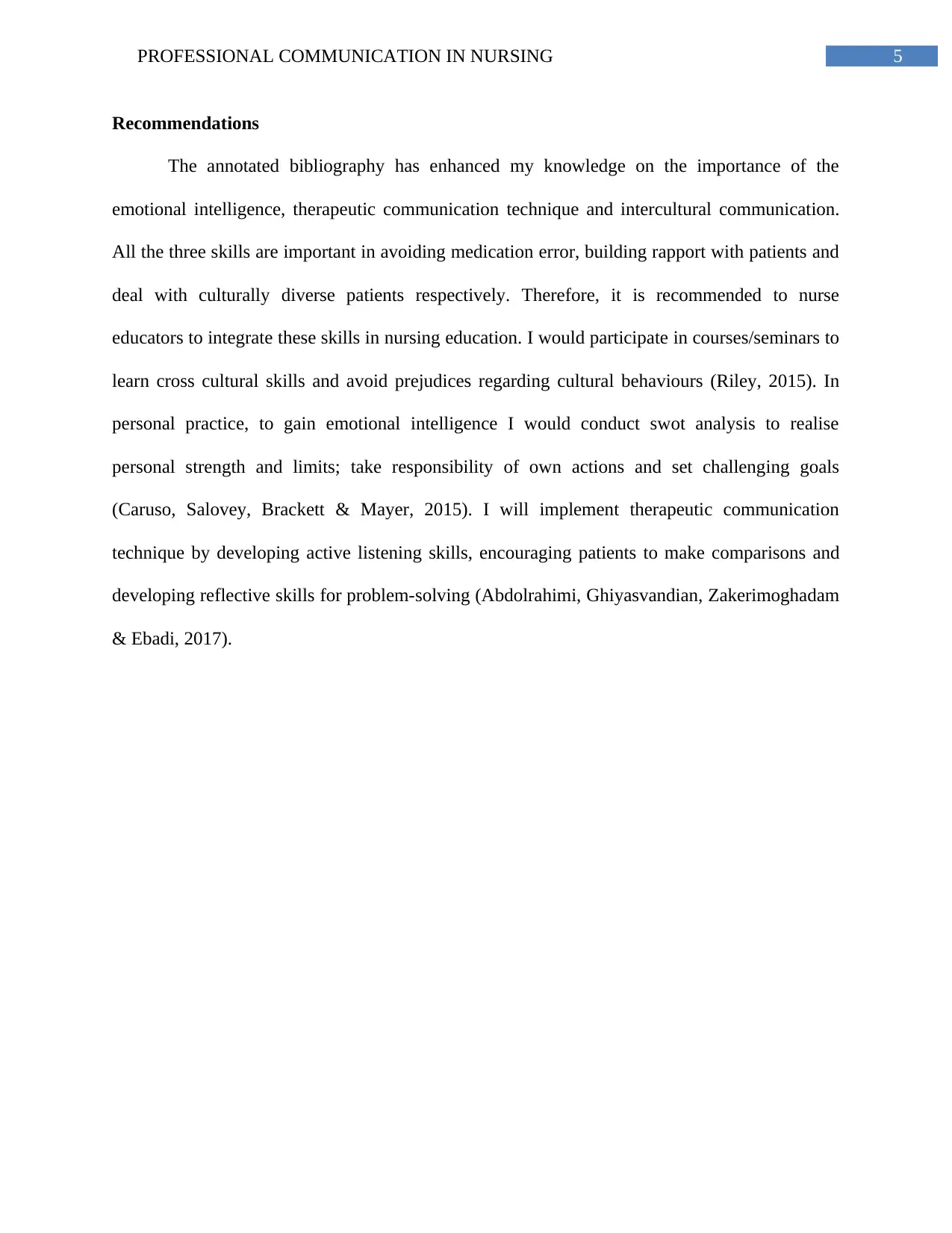
5PROFESSIONAL COMMUNICATION IN NURSING
Recommendations
The annotated bibliography has enhanced my knowledge on the importance of the
emotional intelligence, therapeutic communication technique and intercultural communication.
All the three skills are important in avoiding medication error, building rapport with patients and
deal with culturally diverse patients respectively. Therefore, it is recommended to nurse
educators to integrate these skills in nursing education. I would participate in courses/seminars to
learn cross cultural skills and avoid prejudices regarding cultural behaviours (Riley, 2015). In
personal practice, to gain emotional intelligence I would conduct swot analysis to realise
personal strength and limits; take responsibility of own actions and set challenging goals
(Caruso, Salovey, Brackett & Mayer, 2015). I will implement therapeutic communication
technique by developing active listening skills, encouraging patients to make comparisons and
developing reflective skills for problem-solving (Abdolrahimi, Ghiyasvandian, Zakerimoghadam
& Ebadi, 2017).
Recommendations
The annotated bibliography has enhanced my knowledge on the importance of the
emotional intelligence, therapeutic communication technique and intercultural communication.
All the three skills are important in avoiding medication error, building rapport with patients and
deal with culturally diverse patients respectively. Therefore, it is recommended to nurse
educators to integrate these skills in nursing education. I would participate in courses/seminars to
learn cross cultural skills and avoid prejudices regarding cultural behaviours (Riley, 2015). In
personal practice, to gain emotional intelligence I would conduct swot analysis to realise
personal strength and limits; take responsibility of own actions and set challenging goals
(Caruso, Salovey, Brackett & Mayer, 2015). I will implement therapeutic communication
technique by developing active listening skills, encouraging patients to make comparisons and
developing reflective skills for problem-solving (Abdolrahimi, Ghiyasvandian, Zakerimoghadam
& Ebadi, 2017).
⊘ This is a preview!⊘
Do you want full access?
Subscribe today to unlock all pages.

Trusted by 1+ million students worldwide
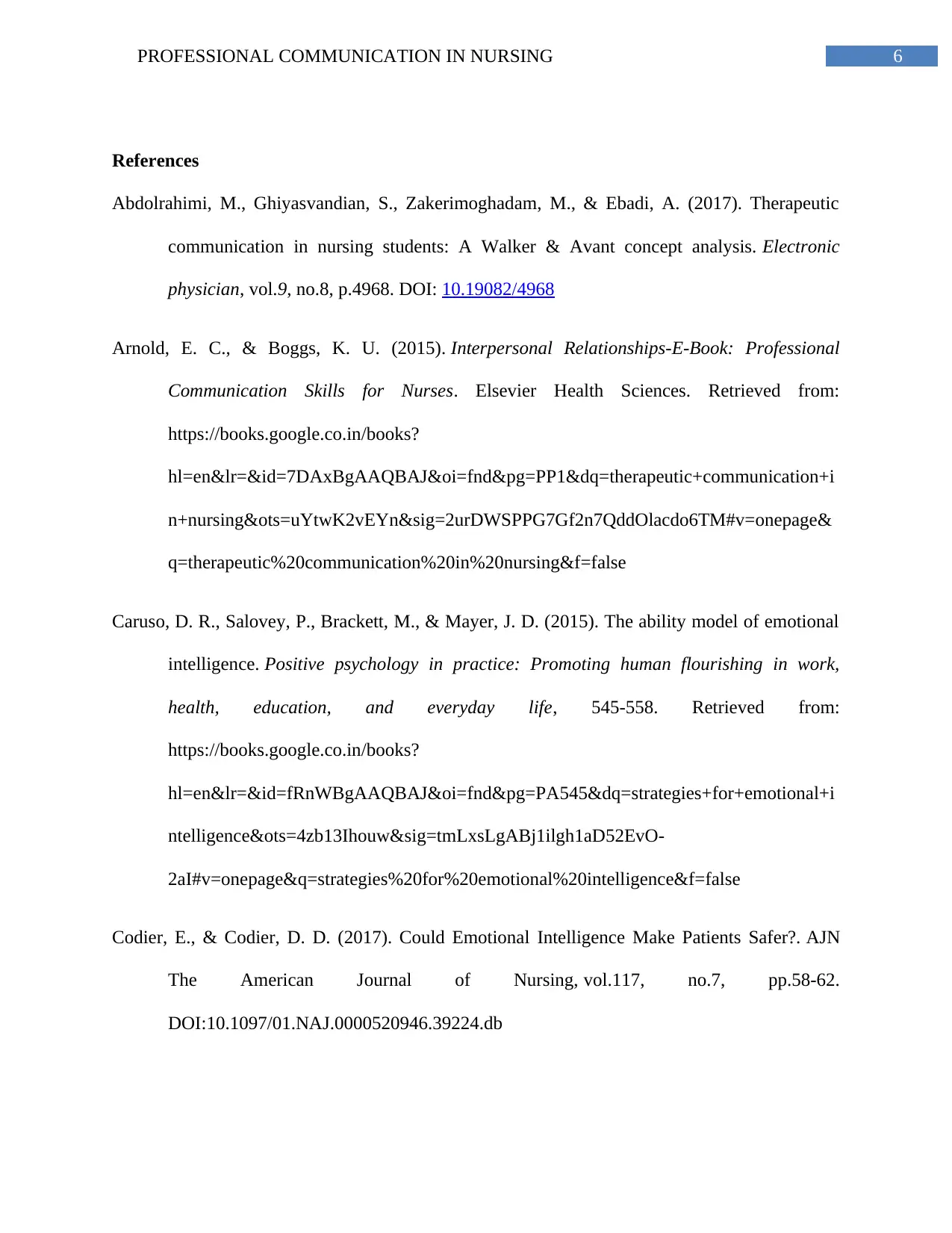
6PROFESSIONAL COMMUNICATION IN NURSING
References
Abdolrahimi, M., Ghiyasvandian, S., Zakerimoghadam, M., & Ebadi, A. (2017). Therapeutic
communication in nursing students: A Walker & Avant concept analysis. Electronic
physician, vol.9, no.8, p.4968. DOI: 10.19082/4968
Arnold, E. C., & Boggs, K. U. (2015). Interpersonal Relationships-E-Book: Professional
Communication Skills for Nurses. Elsevier Health Sciences. Retrieved from:
https://books.google.co.in/books?
hl=en&lr=&id=7DAxBgAAQBAJ&oi=fnd&pg=PP1&dq=therapeutic+communication+i
n+nursing&ots=uYtwK2vEYn&sig=2urDWSPPG7Gf2n7QddOlacdo6TM#v=onepage&
q=therapeutic%20communication%20in%20nursing&f=false
Caruso, D. R., Salovey, P., Brackett, M., & Mayer, J. D. (2015). The ability model of emotional
intelligence. Positive psychology in practice: Promoting human flourishing in work,
health, education, and everyday life, 545-558. Retrieved from:
https://books.google.co.in/books?
hl=en&lr=&id=fRnWBgAAQBAJ&oi=fnd&pg=PA545&dq=strategies+for+emotional+i
ntelligence&ots=4zb13Ihouw&sig=tmLxsLgABj1ilgh1aD52EvO-
2aI#v=onepage&q=strategies%20for%20emotional%20intelligence&f=false
Codier, E., & Codier, D. D. (2017). Could Emotional Intelligence Make Patients Safer?. AJN
The American Journal of Nursing, vol.117, no.7, pp.58-62.
DOI:10.1097/01.NAJ.0000520946.39224.db
References
Abdolrahimi, M., Ghiyasvandian, S., Zakerimoghadam, M., & Ebadi, A. (2017). Therapeutic
communication in nursing students: A Walker & Avant concept analysis. Electronic
physician, vol.9, no.8, p.4968. DOI: 10.19082/4968
Arnold, E. C., & Boggs, K. U. (2015). Interpersonal Relationships-E-Book: Professional
Communication Skills for Nurses. Elsevier Health Sciences. Retrieved from:
https://books.google.co.in/books?
hl=en&lr=&id=7DAxBgAAQBAJ&oi=fnd&pg=PP1&dq=therapeutic+communication+i
n+nursing&ots=uYtwK2vEYn&sig=2urDWSPPG7Gf2n7QddOlacdo6TM#v=onepage&
q=therapeutic%20communication%20in%20nursing&f=false
Caruso, D. R., Salovey, P., Brackett, M., & Mayer, J. D. (2015). The ability model of emotional
intelligence. Positive psychology in practice: Promoting human flourishing in work,
health, education, and everyday life, 545-558. Retrieved from:
https://books.google.co.in/books?
hl=en&lr=&id=fRnWBgAAQBAJ&oi=fnd&pg=PA545&dq=strategies+for+emotional+i
ntelligence&ots=4zb13Ihouw&sig=tmLxsLgABj1ilgh1aD52EvO-
2aI#v=onepage&q=strategies%20for%20emotional%20intelligence&f=false
Codier, E., & Codier, D. D. (2017). Could Emotional Intelligence Make Patients Safer?. AJN
The American Journal of Nursing, vol.117, no.7, pp.58-62.
DOI:10.1097/01.NAJ.0000520946.39224.db
Paraphrase This Document
Need a fresh take? Get an instant paraphrase of this document with our AI Paraphraser
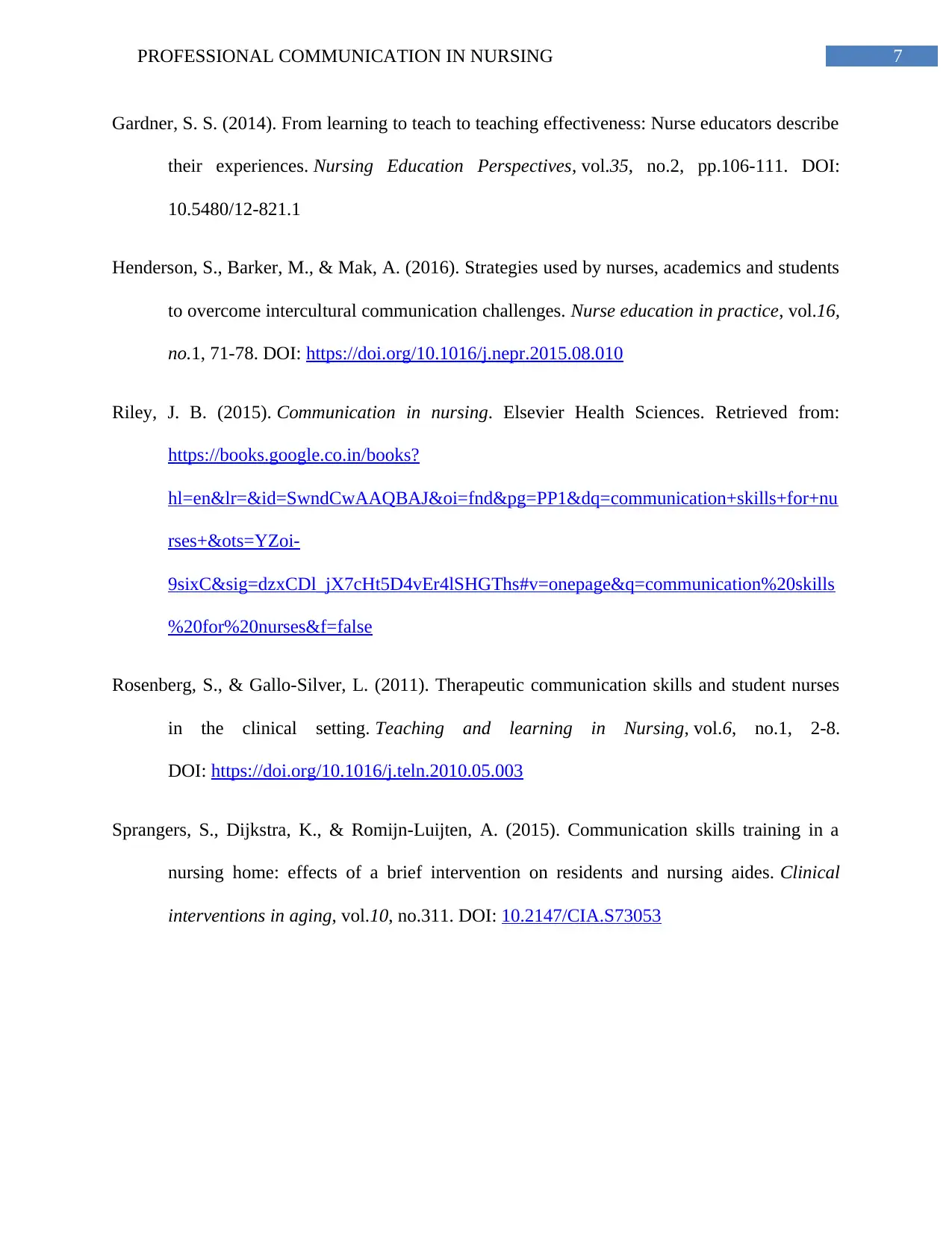
7PROFESSIONAL COMMUNICATION IN NURSING
Gardner, S. S. (2014). From learning to teach to teaching effectiveness: Nurse educators describe
their experiences. Nursing Education Perspectives, vol.35, no.2, pp.106-111. DOI:
10.5480/12-821.1
Henderson, S., Barker, M., & Mak, A. (2016). Strategies used by nurses, academics and students
to overcome intercultural communication challenges. Nurse education in practice, vol.16,
no.1, 71-78. DOI: https://doi.org/10.1016/j.nepr.2015.08.010
Riley, J. B. (2015). Communication in nursing. Elsevier Health Sciences. Retrieved from:
https://books.google.co.in/books?
hl=en&lr=&id=SwndCwAAQBAJ&oi=fnd&pg=PP1&dq=communication+skills+for+nu
rses+&ots=YZoi-
9sixC&sig=dzxCDl_jX7cHt5D4vEr4lSHGThs#v=onepage&q=communication%20skills
%20for%20nurses&f=false
Rosenberg, S., & Gallo-Silver, L. (2011). Therapeutic communication skills and student nurses
in the clinical setting. Teaching and learning in Nursing, vol.6, no.1, 2-8.
DOI: https://doi.org/10.1016/j.teln.2010.05.003
Sprangers, S., Dijkstra, K., & Romijn-Luijten, A. (2015). Communication skills training in a
nursing home: effects of a brief intervention on residents and nursing aides. Clinical
interventions in aging, vol.10, no.311. DOI: 10.2147/CIA.S73053
Gardner, S. S. (2014). From learning to teach to teaching effectiveness: Nurse educators describe
their experiences. Nursing Education Perspectives, vol.35, no.2, pp.106-111. DOI:
10.5480/12-821.1
Henderson, S., Barker, M., & Mak, A. (2016). Strategies used by nurses, academics and students
to overcome intercultural communication challenges. Nurse education in practice, vol.16,
no.1, 71-78. DOI: https://doi.org/10.1016/j.nepr.2015.08.010
Riley, J. B. (2015). Communication in nursing. Elsevier Health Sciences. Retrieved from:
https://books.google.co.in/books?
hl=en&lr=&id=SwndCwAAQBAJ&oi=fnd&pg=PP1&dq=communication+skills+for+nu
rses+&ots=YZoi-
9sixC&sig=dzxCDl_jX7cHt5D4vEr4lSHGThs#v=onepage&q=communication%20skills
%20for%20nurses&f=false
Rosenberg, S., & Gallo-Silver, L. (2011). Therapeutic communication skills and student nurses
in the clinical setting. Teaching and learning in Nursing, vol.6, no.1, 2-8.
DOI: https://doi.org/10.1016/j.teln.2010.05.003
Sprangers, S., Dijkstra, K., & Romijn-Luijten, A. (2015). Communication skills training in a
nursing home: effects of a brief intervention on residents and nursing aides. Clinical
interventions in aging, vol.10, no.311. DOI: 10.2147/CIA.S73053
1 out of 8
Related Documents
Your All-in-One AI-Powered Toolkit for Academic Success.
+13062052269
info@desklib.com
Available 24*7 on WhatsApp / Email
![[object Object]](/_next/static/media/star-bottom.7253800d.svg)
Unlock your academic potential
Copyright © 2020–2025 A2Z Services. All Rights Reserved. Developed and managed by ZUCOL.





